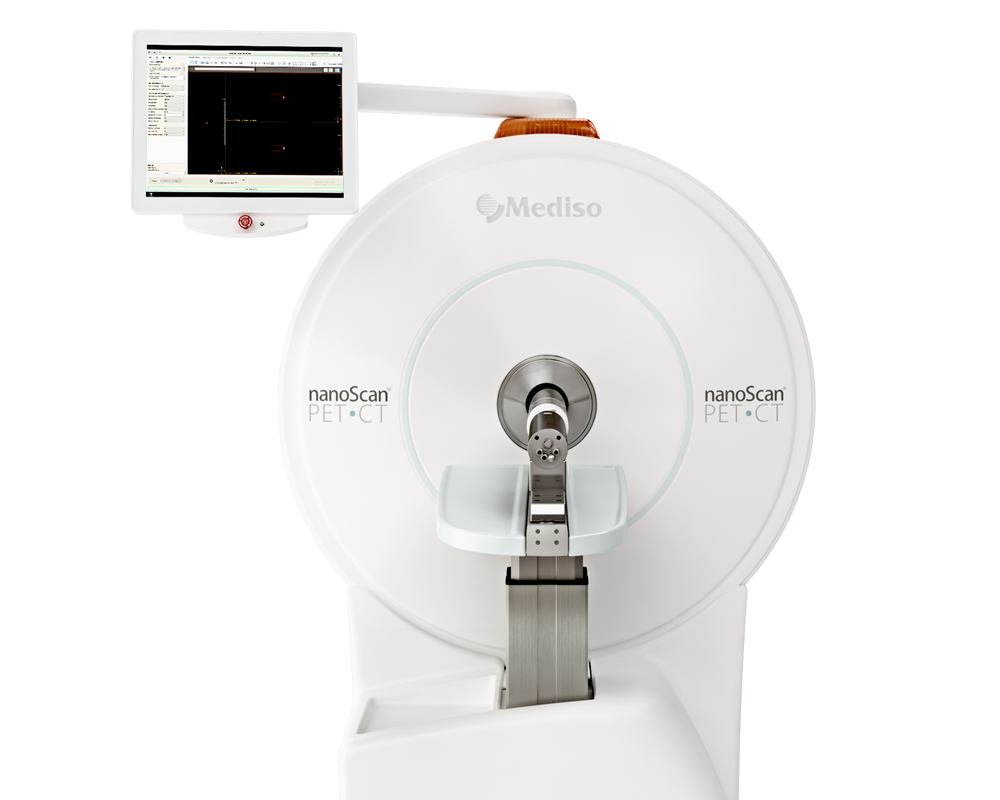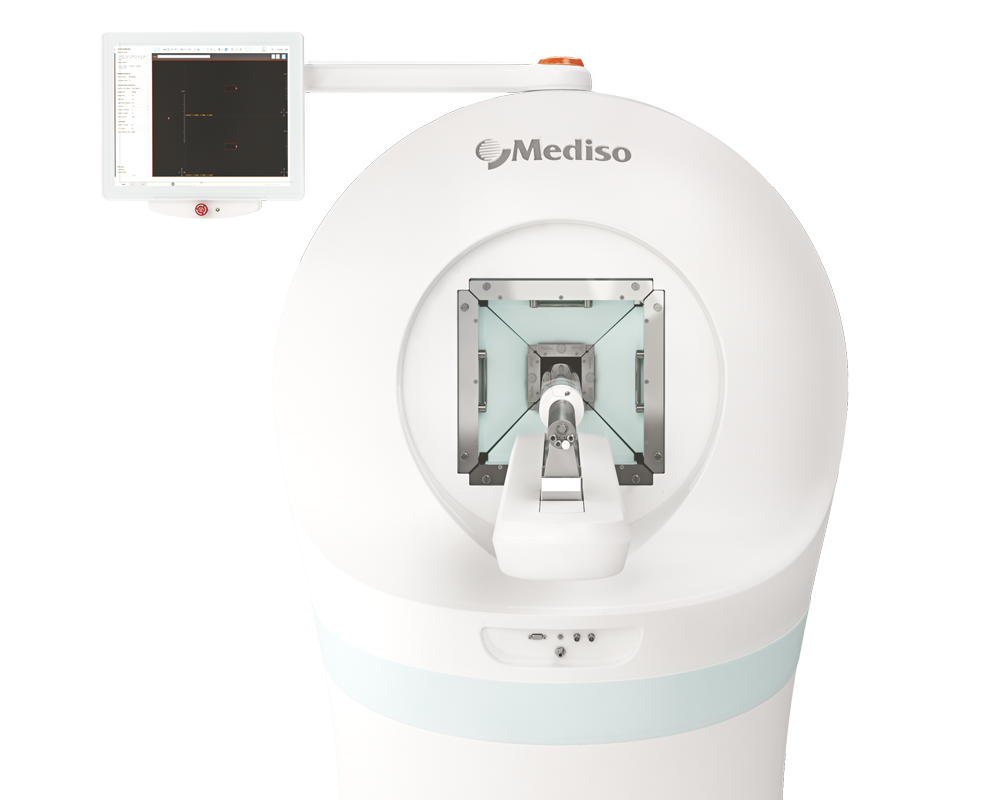Preclinical evaluation of [225Ac]Ac-PSMA-617 and in vivo effect comparison in combination with [177Lu]Lu-PSMA-617 for prostate cancer
2025.03.28.
E. Savio et al, Nuclear Medicine and Biology, 2025
Summary
Introduction: The interest in targeted alpha therapy (TAT) has grown in the recent years as it can provide new treatment options for advanced- and late-stage cancer. In this sense, the use of actinium-225 is rising showing promising results. Even more, combining alpha and beta (lutetium-177) radionuclides might help to minimize actinium adverse effects, while preserving treatment efficacy. Preclinical studies of actinium-225-PSMA-targeting tracers for advanced prostate cancer and the “cocktail” combination with lutetium-177-PSMA needs to be further explored.
Methods: In vitro properties of [225Ac]Ac-PSMA-617 using the human prostatic cancer cell lines, LNCaP (PSMA+) and PC3 (PSMA-) were investigated by means of antiproliferative, binding, cytotoxicity and clonogenic studies. In vivo de-escalated treatment protocols of actinium-225/lutetium-177-PSMA-617 “cocktail”-regimens were also assessed in order to improve the tolerability of 225Ac-PSMA-617 TAT. A four-branch study with ([177Lu]LuPSMA-617 and [225Ac]Ac-PSMA-617) or its combination was successfully performed in a xenographic nude mice model bearing prostate cancer. Tumour growth was monitored by external caliper measurements and PET-CT imaging with [18F]F-AlF-PSMA-11 over two months.
Results: Specific dose-dependent inhibition proliferation of [225Ac]Ac-PSMA-617 was observed in LNCaP cells whereas an antiproliferative effect in PC3 cells required an activity concentration two orders of magnitude higher. In autoradiography binding studies, [225Ac]Ac-PSMA-617 had significant higher affinity for LNCaP cells, compared to PC3 cells, which probed to be specific under blocking conditions. Cytotoxicity assay evidenced a 200-fold higher toxicity in LNCaP cells. The percentage of colony survival significantly decreased in LNCaP cells treated with 1KBq/mL and 10KBq/mL, as compared to PC3 cells treated with the same activity concentrations. The co-administration of both beta and alpha therapeutical ra diopharmaceuticals to xenographic nude mice model bearing prostate cancer showed the best results in terms of survival, growth rates and absence of tumour at the endpoint of the study.
Conclusion: This study shows that PSMA radioisotope therapy (RIT) and TAT combined therapy could improve patient management by delaying disease progression.
Results from nanoScan® PET/CT
Ten- to twelve-week-old male athymic nude mice were subcutaneously implanted in the left flank with 5×106 LNCaP cells. A small portion of testosterone gel was applied daily to the skin of the mice until the appearance of tumours as a small dark-blue dot. Tumour growth was monitored by external caliper measurements and by PET-CT imaging with [18F]F-AlF-PSMA-11 over two months. Treatment with radiopharmaceuticals [225Ac]Ac-PSMA-617 and [177Lu]Lu-PSMA-617 were carried out intravenously. Four groups were studied: one for each individual treatment of each radiopharmaceutical (groups 1 and 2), one based on a combination of both radiopharmaceutical (group 3) and a control one (group 4). Average activity was 98±5KBq for [225Ac]Ac-PSMA-617; 102±18MBq for [177Lu]Lu-PSMA-617; 36±9KBq and 37.0±8.7MBq respectively when both radiopharmaceuticals [225Ac]Ac-PSMA-617 + [177Lu]LuPSMA-617 were co-administered. In all cases maximum volume to be injected was 0.2mL. Radiopharmaceuticals were administered intravenously via main tail vein once tumours reached a volume of 25–300mm3, approximately 3–8 weeks post inoculation. Therapeutic response was followed by in vivo imaging studies with a reference radiotracer for prostate cancer ([18F]F-AlF-PSMA-11),which was administered both prior to radiotherapeutic treatment to assess baseline tumour uptake, and during follow-up to monitor therapeutic response. Tumour growth was also measured externally by caliber and recorded after the acquisition of each PET/CT study. Characterization was performed weekly, evaluating the different tumour stages; pretreatment week (all groups), and post-treatment weeks 1, 2, 4, and 8 ([225Ac]Ac-PSMA-617 and/or [177Lu]Lu-PSMA-617). The control group was followed weekly (weeks 0, 1, 2 and 3) until its sacrifice was necessary due to tumour growth. For PET imaging, administration of the radiopharmaceutical was intravenous [maximum volume injected 0.2mL, activity (45.4±9.5) MBq, through the caudal tail vein] all animals of the 4 groups detailed above were used. Small animal PET-CT imaging was performed in a nanoScan® PET/CT Mediso Medical Imaging Systems, based on LYSO scintillator. PET acquisition (static studies) started 30 min after the bolus injection of [18F]F-AlF-PSMA-11 for each mouse, the acquisition time was 40min, followed by the CT scan of each animal (time approximately 2min). During the whole period under study the animals remained sedated by inhalation with 2.5% Isoflurane at an O2 flow of (1.5–2.0) L/min. Scans were reconstructed using 3D maximum likelihood expectation maximization (3D-MLEM) with 4 iterations and 6 subsets. Tumour segmentation was performed on PET images by applying a semi-automatic algorithm (Region Growing, PMOD 3.8 Technologies, Ltd., Zurich, Switzerland) to define the volumes of interest (VOIs). Tumour volume and the average and total radiopharmaceutical bind (sum) to tumour were calculated. Additionally, a contralateral spherical region of fixed size of 2mm was manually defined to represent normal tissue nonspecific signal. The tumour/normal uptake ratio (TNr) was calculated from this data. The data were finally normalized to the initial volume and uptake of each tumour, prior to starting the treatment.
Results show:
- Treatments with the radiopharmaceuticals [225Ac]Ac-PSMA-617 and [177Lu]Lu-PSMA-617 individually, or a combination of both, were successfully carried out in a xenographic mice model (Fig. 8-10.)

Fig. 8. Representative [18F]AlF-PSMA-11 PET image of each treatment group 7 days after treatment

Fig. 9. Representative [18F]AlF-PSMA-11 PET image of each treatment group 30 days after treatment.

Fig. 10. Evolution of normalized tumour volume in 0–8 week after each treatment. Continuous tumour expansion was observed in all mice in the control group. The maximum volume was observed in week 3, when the mice were sacrificed, as established in the protocol. In groups that received a single dose of [177Lu]Lu-PSMA-617 or [225Ac]Ac-PSMA-617, an initial reduc tion of tumour volume was verified, followed by a rapid tumour development between weeks 4 to 8. In the combined treatment with both radiopharmaceuticals, tumour volume decreased over weeks, being undetectable in 40% of subjects at week 8.
- The overall efficiency of the treatments is shown in Fig. 12 representing survival and tumour detectability rates. In the control group, tumour detectability was 100% in all acquisitions and the survival rate was 60% in week 3 and 0% in week 4.

Fig. 12. Overall efficiency of the treatments by plotting survival and tumour detectability rates. In the control group, tumour detectability was 100% in all acquisitions, and the survival rate was 60% in week 3 and 0% in week 4.
PSMA radioisotope therapy and targeted alpha combined therapy opens doors to a better future for patients, in case the disease progression could be delayed as shown in this preclinical study. Our results could contribute to broadening the pre clinical studies that are performed with actinium-225- radiopharmaceuticals for an improved understanding of their biological effects, as well as lay the foundation for wider future studies.
Full article on sciencedirect.com
Wie können wir Ihnen behilflich sein?
Bitte kontaktieren Sie uns für technische Informationen und Unterstützung jeglicher Art in Zusammenhang mit unseren Entwicklungen und Produkten.
Kontaktformular
